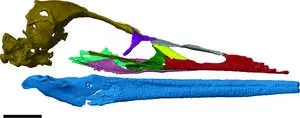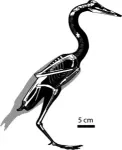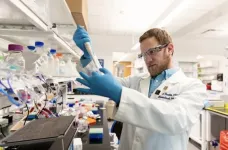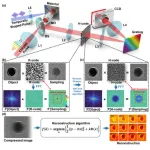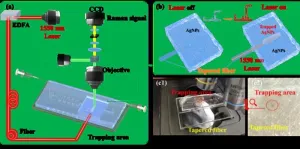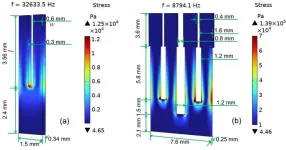(Press-News.org) A new study in Nature describing a fossil of a nearly complete and intact bird skull from Antarctica is shedding light on the early evolution of today’s birds and avian diversity at the end of the Age of Dinosaurs.
The skull is from Vegavis iaai, an extinct duck-like bird that lived during the Late Cretaceous, just before non-avian dinosaurs went extinct. It’s one of very few 3D bird skulls known to science from the Cretaceous — a 79-million-year geological period and the last era when non-avian dinosaurs walked the Earth.
Vegavis is among the best-known bird species from this era. There are multiple fossils of this bird, including the oldest known fossil bird vocal organ. But research on the new skull — and the shape of the brain inside it — isn’t only helping scientists learn more about this particular extinct bird species, but the origins and evolution of birds that are still living today.
“There are very few brains to illuminate this phase of avian evolution,” said Chris Torres, an assistant professor at the University of the Pacific, who led the study.
Torres conducted the research as a National Science Foundation postdoctoral fellow at Ohio University, and began it as a graduate student at The University of Texas at Austin, working with Julia Clarke, a professor at the UT Jackson School of Geosciences.
The new study is the latest in a long list of Vegavis discoveries by Clarke. She and colleagues identified and named the species in 2005, working with a specimen that was discovered on Antarctica’s Vega Island in 1992. The specimen was the first example of a direct relative of modern birds from the Late Cretaceous — and served as evidence that living bird relatives and their non-avian dinosaur cousins co-existed. In 2016, Clarke and other collaborators discovered a fossilized syrinx — a bird vocal organ — in a different Vegavis specimen. And in 2011, she was part of the fossil finding mission to Antarctica where the skull was discovered by study co-author and geologist Eric Roberts, a professor at the Colorado School of Mines.
When Clarke identified Vegavis, she determined that it was closely related to modern ducks and geese and could be categorized in an evolutionary group called Anseriformes that encompasses both types of birds. But since then, other researchers have suggested that Vegavis is much more distantly related to most bird lineages today.
“Few birds are as likely to start as many arguments among paleontologists as Vegavis,” said Torres.
But answering the question of where Vegavis lands on the tree of life isn’t just a technical point of discussion between paleontologists. It can help answer a big open question in bird evolution: Did it take the demise of non-avian dinosaurs for modern birds to diversify into the many lineages still with us today? Or was this diversification already well underway during the Age of Dinosaurs? Also, what role, if any, did the asteroid impact that ended the Cretaceous have on modern birds and their diversification?
Thanks to this new study, the researchers have confidently found a taxonomic home for Vegavis. Its broad collection of anatomical traits keeps it in the Anseriformes group, as Clarke previously hypothesized. This outcome suggests that the earliest diverging modern bird lineages were evolving alongside non-avian dinosaurs.
Its placement came as a bit of a surprise, according to the researchers. That’s because the Vegavis skull has some decidedly un-ducklike features. Most notably, a long, spear-shaped beak.
“I think it gave some people pause,” Clarke said. “They expected [the skull] to be more duck or goose like.”
Clarke notes that the ducks and geese of today are just a small selection of the anseriform birds that have lived over time. There are examples from the fossil record of duck-like birds that had lifestyles akin to today’s herons and flamingos. Vegavis and its distinctive beak underscore the diversity of duck-like birds that once walked the Earth.
“In the past they were weird and wonderful,” Clarke said. “We have this huge range [of now-extinct anseriform birds] and Vegavis is consistent with that.”
This study also highlights the value of deeply researching a single species. Clarke and her colleagues have spent decades analyzing Vegavis fossils from Antarctica. But what they have discovered is having ripple effects across the entire evolutionary tree, said co-author Patrick O’Connor, a professor at Ohio University and the director of Earth and Space Sciences at the Denver Museum of Nature & Science.
“This new fossil reveals that Antarctica has much to tell us about the earliest stages of modern bird evolution,” he said.
Fossils of animals and plants from this time in Antarctica are extremely rare, leading to many more questions about the nature of the environments in which birds and other life forms originated and diversified.
“Something very different seems to have been happening in the far reaches of the Southern Hemisphere, specifically in Antarctica,” said O’Connor. “This requires a much closer look into the fossil record and the changing environments of this region through time.”
The study’s additional co-authors are Joseph Groenke of Ohio University, Matthew Lamanna of Carnegie Museum of Natural History, Ross MacPhee of the American Museum of Natural History, and Grace Musser of UT Austin and the Smithsonian National Museum of Natural History.
The research was funded by the National Science Foundation.
END
Rare bird skull from the age of dinosaurs helps illuminate avian evolution
2025-02-08
ELSE PRESS RELEASES FROM THIS DATE:
Researchers find high levels of the industrial chemical BTMPS in fentanyl
2025-02-08
A UCLA research team has found that drugs being sold as fentanyl contain high amounts of the industrial chemical bis(2,2,6,6-tetramethyl-4-piperidyl) sebacate, or BTMPS. This new substance of concern emerged in the illicit drug supply nearly simultaneously in multiple U.S. locations from coast-to-coast.
From June through October 2024, the team quantitatively tested samples of drugs sold as fentanyl that had high levels of the chemical, which belongs to a class of compounds called hindered amine light stabilizers ...
Decoding fat tissue
2025-02-08
As many as 40% of Americans are obese, putting them at an increased risk for high blood pressure, diabetes, stroke, heart disease and certain cancers, according to the CDC. New research from the University of Delaware aims to tackle the issue by investigating obesity at the gene level.
Principal investigator Ibra Fancher, assistant professor of kinesiology and applied physiology in UD’s College of Health Sciences, discovered significant differences in gene expression in adipose tissue, more commonly known as fat. Formerly considered fat storage, adipose tissue is now recognized as a vital ...
Solar and electric-powered homes feel the effects of blackouts differently, according to new research from Stevens
2025-02-08
Hoboken, N.J., February 7, 2025 — As winter storms and summer heat waves increasingly stress the nation’s power grids, Stevens researchers have developed a new way to identify the homes most vulnerable to blackouts — without even visiting them.
The timing couldn't be more critical. With more than a quarter of U.S. homes already fully electric, and solar installations set to triple during the next five years, understanding vulnerabilities has become critical for emergency planning and public safety.
"We're ...
Metal ion implantation and laser direct writing dance together: constructing never-fading physical colors on lithium niobate crystals
2025-02-07
A new publication from Opto-Electronic Advances; DOI 10.29026/oea.2025.240193 , discusses a novel approach towards robust construction of physical colors on lithium niobate crystal.
Color has a profound impact on the way humans observe, perceive and understand the world. It is like a silent language, subtly shaping our perception and response to the surrounding environment. From the first ray of sunshine in the morning to the twinkling stars in the night sky, colors are everywhere. They are not only a visual ...
High-frequency enhanced ultrafast compressed photography technology (H-CAP) allows microscopic ultrafast movie to appear at a glance
2025-02-07
A new publication from Opto-Electronic Advances; DOI 10.29026/oea.2025.240180 , discusses high-frequency enhanced ultrafast compressed photography technology.
Single-shot ultrafast imaging technology can characterize transient events under a wide range of conditions. It opens the door to explore the unrepeatable or difficult to reproduce ultrafast phenomena such as photosynthesis at the molecular or atomic scale in nature and the precision manufacturing of semiconductor ...
Single-beam optical trap-based surface-enhanced raman scattering optofluidic molecular fingerprint spectroscopy detection system
2025-02-07
A new publication from Opto-Electronic Advances; DOI 10.29026/oea.2025.240182 , discusses a single-beam optical trap-based surface-enhanced Raman scattering optofluidic molecular fingerprint spectroscopy detection system.
Raman spectroscopy is a non-destructive analytical technique that allows for precise analysis of substances based on their unique molecular Raman spectral characteristics. However, traditional Raman spectroscopy techniques suffer from weak signal intensity, limiting their sensitivity in high-sensitivity detection applications. Surface-enhanced Raman scattering (SERS) technology, on the other hand, can amplify Raman signals by several million ...
Removing large brain artery clot, chased with clot-buster shot may improve stroke outcomes
2025-02-07
Research Highlights:
Stroke survivors were more likely to have little or no disability after 90 days if a clot was removed from a large brain artery followed by the injection of the clot-dissolving medication tenecteplase directly into the artery near the blockage, compared to people receiving standard medical treatment after clot removal. In this trial, standard care was clot removal without clot-dissolving medication.
The added treatment may work by dissolving blood clots in the small vessels (microcirculation) near the major blockage, reducing the amount of brain tissue deprived of blood.
The ANGEL-TNK trial found that this approach was ...
A highly sensitive laser gas sensor based on a four-prong quartz tuning fork
2025-02-07
A new publication from Opto-Electronic Advances; DOI 10.29026/oea.2025.240275, discusses A highly sensitive laser gas sensor based on a four-prong quartz tuning fork.
Trace gases, though have a volume fraction much less than 1% of the atmosphere, significantly impact various sectors. Despite their low concentration, typically between 10-12 to 10-6, gases like nitrogen oxides (NOx), sulfur dioxide (SO2), and greenhouse gases contribute to atmospheric pollution, a pressing global issue exacerbated by industrialization and urbanization. Moreover, detecting trace gases is crucial for industrial ...
Generation of Terahertz complex vector light fields on a metasurface driven by surface waves
2025-02-07
A new publication from Opto-Electronic Sciences; DOI 10.29026/oes.2025.240024, discusses generation of terahertz complex vector light fields on a metasurface driven by surface waves.
With the rapid development of information and communication technologies, especially in the context of 5G, 6G networks, artificial intelligence, and the Internet of Things, the development of on-chip optical control devices with high bandwidth, high speed, low power consumption, and miniaturization ...
Clot-busting meds may be effective up to 24 hours after initial stroke symptoms
2025-02-07
Research Highlights:
In a randomized clinical trial in China, giving the clot-busting medication alteplase up to 24 hours after stroke symptoms first appeared increased the odds of better recovery by 50% compared to those who received standard antiplatelet treatment.
The results might extend the time window for patient treatment worldwide, particularly in regions that lack access to advanced medical procedures.
Note: The study featured in this news release is a research abstract. Abstracts presented at the American Heart ...

